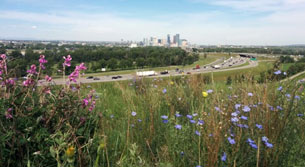Habitat restoration
Habitat restoration is the active process of improving the health and resilience of our parks and green spaces. It involves the purposeful introduction of plants that reflect our natural landscape. This practice supports the biodiversity of Calgary and the wellbeing of Calgarians.
Why is habitat restoration important?
Habitat restoration offers many benefits to our city, and tremendous value to you as a citizen. Habitat restoration:
- creates sustainable landscapes that help support plant, animal and insect life;
- makes our parks and green spaces more resilient to climate change and extreme weather events;
- increases the beauty and diversity of Calgary’s landscapes;
- promotes mental health and relaxation by increasing access to nature;
- provides more diverse recreational opportunities; and,
- reduces long-term maintenance costs including mowing, fertilizing, applying pesticides, and irrigating.
As a key biodiversity target, we aim to restore 20% of Calgary’s open space by 2025.

Frequently Asked Questions
How are habitat restoration sites selected?
We consider several factors, including:
- existing health of the park;
- public safety;
- potential to enhance wildlife habitat and the types present;
- site location within the network of Calgary’s and the region’s green spaces;
- potential impacts to park users;
- utilities and neighbouring residences; and,
- maintenance costs.
How will this affect my community park?
Some habitat restoration projects allow native grasses to grow without being cut. Others may change the types of plants or landscape elements, such as restoring a wetland. The simpler habitat restoration projects are called naturalization, which may include removing non-native plants, seeding and planting with native plants, and no longer mowing the site. Project duration depends on the type of work being completed.
Before we begin any work, we consider potential impacts to park users. Parks will send information to communities by various means including through community associations and Councillors’ Offices.
Please respect any area closures: Restored sites are very sensitive to foot traffic in the early stages while the vegetation establishes.
How long will restoration take?
Restoration takes time. A project can take three or more years to implement. It can take several years after that to reach the full benefits of the restored area. By investing in our parks and green spaces now, we are helping to ensure these spaces remain healthy so that they continue to be enjoyed in the future by Calgarians, and the wildlife that call our city home.
How can I get involved?
If you are interested in working with us to naturalize a public space, see the Steps to naturalization pamphlet and contact 311.
Bring habitat restoration to your own backyard. Learn tips for backyard naturalization.

